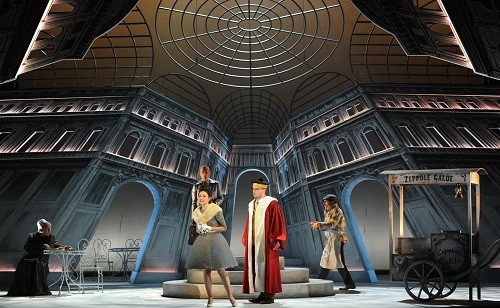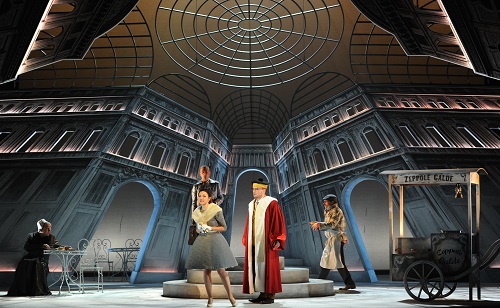 France Sauguet, Les Caprices de Marianne: Orchestre national du Capitole, Claude Schnitzler (conductor), Théâtre du Capitole, Toulouse, 29.1.2016. (JMI)
France Sauguet, Les Caprices de Marianne: Orchestre national du Capitole, Claude Schnitzler (conductor), Théâtre du Capitole, Toulouse, 29.1.2016. (JMI)

Sauguet, Les Caprices de Marianne
Co-production with 15 French opera houses
Direction: Oriol Tomas
Sets: Patricia Ruel
Costumes: Laurence Mongeau
Lighting: Etienne Boucher
Cast:
Marianne: Aurélie Fargues
Octave: Marc Scoffoni
Coelio: François Rougier
Claudio: Norman D. Patzke
Hermia: Julie Robard-Gendre
Tibia: Carl Ghazarossian
Waiter: Xin Wang
Singer: Tiago Matos
Duenna: Julien Bréan
In 2008 the Centre Français de Promotion Lyrique (CFPL) scored a notable success by pooling the resources of several French opera theatres to share the production and artists for Il Viaggio a Reims. The successful staging traveled throughout France for two years, and that excellent initiative has now been repeated with Les Caprices de Marianne. No less than 15 opera houses are taking part, among them companies from Bordeaux, Marseille, Nice and Toulouse. The performances began in late 2014 and will continue through 2016; in all, there will be about 50 performances of this Henri Sauguet opera. The CFPL held a contest to award the stage production, and did the same when assembling the cast of young singers.
Les Caprices de Marianne is one of the few operas composed by Sauguet (1901-1989), and was originally a commission by the Festival of Aix-en-Provence, where it had its premiere in July 1954 without much success. The work is well-constructed musically, and significantly better than other operas of the same time. It’s worth mentioning that Henri Sauguet knows how to write for voices. However it lacks the inspiration needed to become an opera that would be more frequently performed.
The libretto by Jean-Pierre Gredy, based on a work of the same title by Alfred de Musset, sets the action in Naples in the 16th century. It’s a strange plot that begins as a kind of opera buffa but ends in tragedy. The protagonist is the young Marianne, married to Judge Claudio, a sickly, jealous man. The taciturn young Coelio is in love with Marianne, whom he has never met, and seeks the services of his friend Octave to convey his feelings to her, taking advantage of the fact that Octave is Claudio’s cousin. Coelio’s friend delivers the message, much to the surprise of Marianne, who tells her husband about it and excites his unfounded jealousy. The judge threatens to lock Marianne up in a convent, which makes her change her attitude: she gives up being the obedient and faithful wife and discovers that she is in love with Octave.
Following the wishes of Coelio, Octave arranges a meeting between Marianne and his friend. Marianne mistakenly believes that her lover is Octave himself. The plot is discovered by the judge, who instructs a hired assassin to kill Marianne’s lover. Upon arriving at the rendezvous, Coelio is murdered, but Marianne believes that Octave has been killed. He appears, to Marianne’s surprise and joy, but in an emotional final scene, Octave declares that he does not love her.
The stage production is by Oriol Tomas, who moves the action to the 1950s with just one main set for the entire opera: a re-creation of the Umberto I Gallery in Naples, with prop changes for different scenes. The direction narrates the plot well and the lighting is good, but the costumes are not particularly attractive. In short, it is a production that serves the work nicely and has some appealing moments.
The musical direction was entrusted to Claude Schnitzler, a conductor who is very familiar with the music of Henri Sauguet. His reading was excellent and gained in interest as the opera progressed: it was more convincing in the final tragedy than in the initial buffoonery. Under his baton we had the always remarkable Orchestre national du Capitole.
The weak point of the production lies in the cast, which is composed of a group of young singers who in general are not up to their roles. Considering the number of performances that this opera will have, one should have been more demanding in the selection of singers.
Marianne was played by Aurélie Fargues, a very light soprano with an acid timbre. Octave was baritone Marc Scoffoni, a convincing actor but with a voice that is somewhat reduced and not particularly attractive. Tenor François Rougier was Coelio and offered a good but rather small voice. Bass Norman D. Patzke was unsatisfactory as Claudio. Mezzo-soprano Julie Robard-Gendre was Hermia, Coelio’s mother, and she was mischaracterized on stage: no one would ever believe that she could be the mother of Celio.
José M. Irurzun
